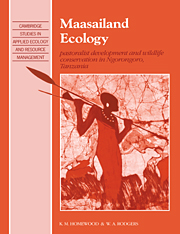Book contents
- Frontmatter
- Contents
- Preface
- 1 Management problems and applied ecology in Ngorongoro Conservation Area
- 2 Ngorongoro Conservation Area
- 3 Maasai of Ngorongoro
- 4 History, politics and perceptions in Ngorongoro
- 5 Management-oriented research in NCA
- 6 Range resources
- 7 Wildlife
- 8 Livestock ecology
- 9 Livestock and wildlife
- 10 Maasai ecology: development, demography and subsistence
- 11 Wildlife conservation and pastoralist development
- 12 Development interventions
- 13 Viewpoint
- References
- Author index
- Subject index
- Map: Ngorongoro Conservation Area, showing the main features and place names used in the text
2 - Ngorongoro Conservation Area
Published online by Cambridge University Press: 08 February 2010
- Frontmatter
- Contents
- Preface
- 1 Management problems and applied ecology in Ngorongoro Conservation Area
- 2 Ngorongoro Conservation Area
- 3 Maasai of Ngorongoro
- 4 History, politics and perceptions in Ngorongoro
- 5 Management-oriented research in NCA
- 6 Range resources
- 7 Wildlife
- 8 Livestock ecology
- 9 Livestock and wildlife
- 10 Maasai ecology: development, demography and subsistence
- 11 Wildlife conservation and pastoralist development
- 12 Development interventions
- 13 Viewpoint
- References
- Author index
- Subject index
- Map: Ngorongoro Conservation Area, showing the main features and place names used in the text
Summary
Ol tau l'enkop-ang The heart of our land
(Maasai expression: Waller 1979)This chapter describes the environment of the NCA and its plant, animal and human resources. It begins with a basic catalogue of the main geomorphological land units. Climate is discussed in terms of the concepts of seasonality, year to year variability and drought. The special nature of the NCA soils, the main vegetation and habitat types, and their wildlife communities are described. The palaeontological and archaeological remains which contribute to NCA's special character and its importance to the world community are outlined. This review of NCA natural and human resources lays the foundation for more detailed examination, in later chapters, of the dynamics of the system, of interactions between species and of conflicts between differing management objectives. At the same time it illustrates both the uniqueness of NCA and the extent to which the area is representative of other African rangelands.
Natural resources
The natural resources of NCA are important to the management of conservation and development on two levels. Firstly, diversity of soils, topography and landform underlie the ecological diversity that supports the rich and abundant wildlife and pastoralist communities. Secondly, the same physical diversity creates a spectacular landscape which of itself exerts a powerful hold on international conservation interest.
(a) NCA land units
Ngorongoro Conservation Area is ecologically continuous with Serengeti National Park (SNP) (Fig. 2.1).
- Type
- Chapter
- Information
- Maasailand EcologyPastoralist Development and Wildlife Conservation in Ngorongoro, Tanzania, pp. 8 - 34Publisher: Cambridge University PressPrint publication year: 1991



